I purchased a SteriPen UV filter a few years back. It was, in all honesty, a bit of a snap-purchase after the element on my MSR filter cracked. I always carried iodine tablets as a backup, but UV filtration was all-the-rage so I thought I’d answer a lingering question: does Steripen work?
There are still, admittedly, times when it feels like you’re trying to purify water with a magic wand, but let me tell you a little more about my Steripen experience.
Article Overview
How Does Steripen Work with UV Purification?

The science behind the effectiveness of ultraviolet (UV) purification is sound. The most notable source of UV radiation on Earth is the sun. In my article on backcountry water filtration, I spoke about the effects of UV radiation from the sun on standing bodies of water, and how that might make them a cleaner source to pull from than moving streams, creeks, or rivers.
UV water filters work the same as the sun, but on a smaller scale. At particular intensities, UV light emits substantial radiation to kill the DNA in bacteria and other microorganisms. In effect, UV rays penetrate harmful pathogens in your water and destroy illness-causing protozoa, eliminating their ability to reproduce.
Most UV water filters, including all Steripen models, contain a light source capable of an output around 254 nanometers which, in the condensed space where they’re used, is of significantly greater intensity than the radiation produced by sunlight.
Is UV Radiation A Standalone Solution?
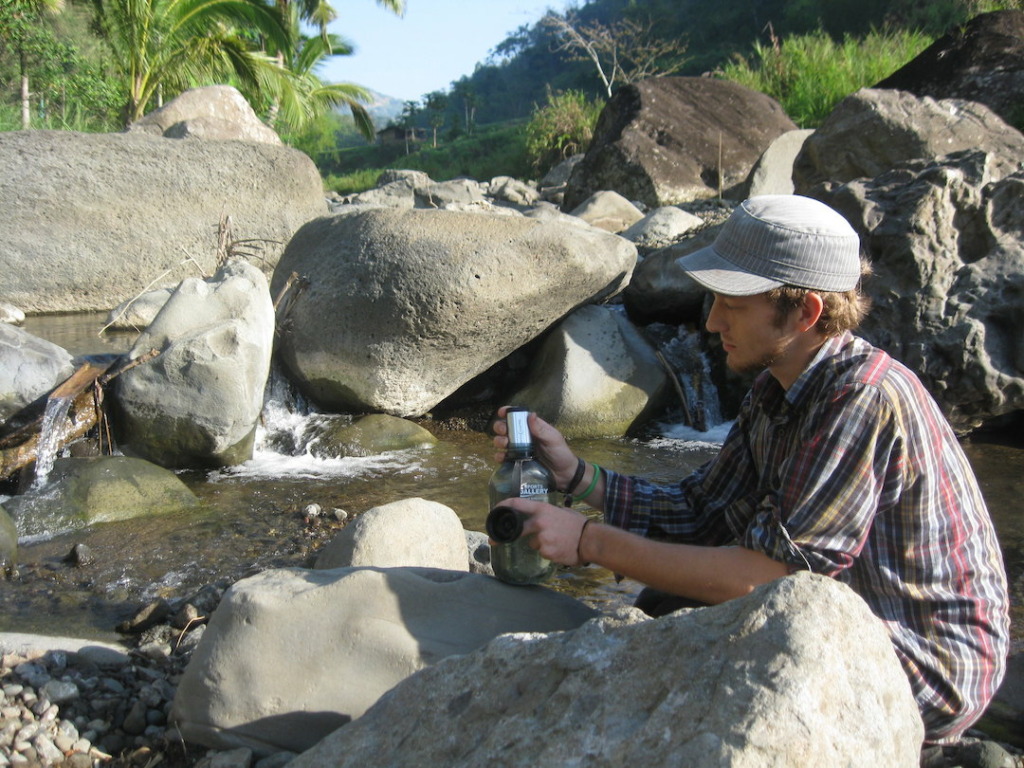
When used as directed, Steripen destroys 99.9999% of bacteria, 99.99% of viruses, and 99.9% of protozoa. The benefits of UV water filtration include the fact that it is chemical-free, requires very little energy, is taste and odor-free, doesn’t need much maintenance, and is extremely effective.
While the percentages above speak for themselves (check out this study for more info!), many companies still recommend using multiple methods of water filtration to ensure the absolute cleanliness of your drinking water. This is especially the case if the water you’re trying to purify isn’t clear.
This is a big point for anyone asking, “Does Steripen work?” The effectiveness of the Steripen isn’t guaranteed, and only reaches this near-100-percent success rate in water that is extremely clear. Darker water won’t allow UV radiation to penetrate throughout and, as a result, should always be additionally filtered using other methods to guarantee safety.
How Does Steripen Work?
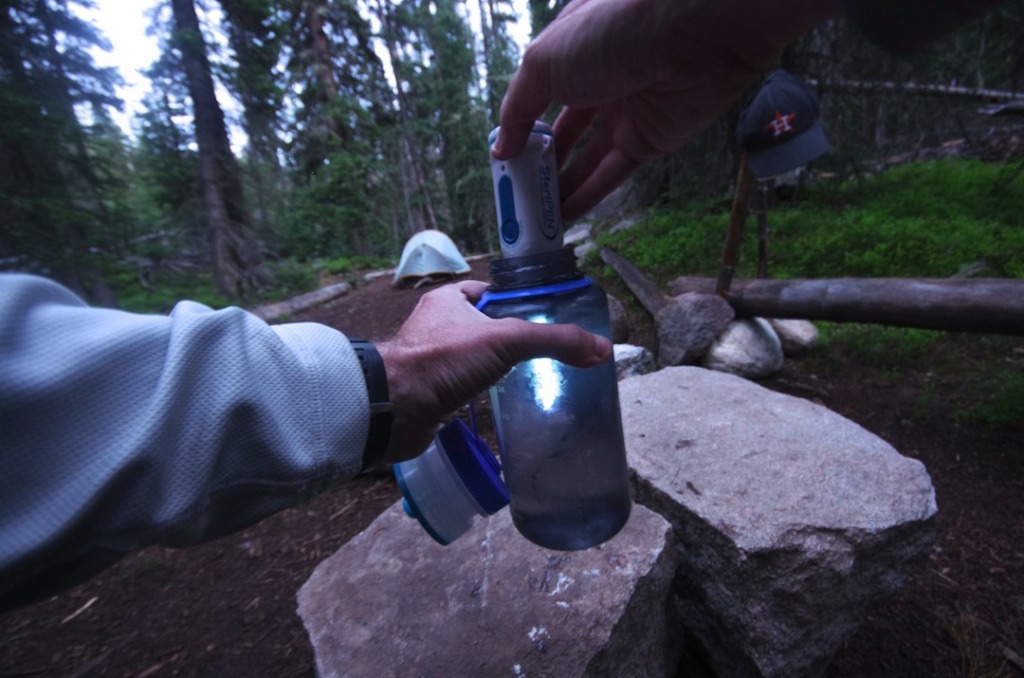
Using the Steripen is a fairly simple process, but can be a bit troublesome if you’re not familiar with it. As I mentioned at the start of this post, it feels a bit like waving a magic wand around in your water for a while in hopes of eradicating bacteria, and as I explain the actual process, perhaps you’ll understand why.
For starters, many models come with a 40-micron pre-filter that attaches to the top of a one-liter Nalgene bottle. This catches larger bacteria and protozoa as you scoop water from the source.
The most important thing to note here is that the sensors must be dry for them to work effectively. This means, as I found out the hard way, you’ll need to dry them off between each use if you’re unsuccessful in your first attempt.
Once you have your bottle full and the protective cap removed from your pen, you’ll need to push the button. One push will purify a half-liter and two pushes will set your pen to purify a full liter. The green LED on the pen will begin flashing (for no more than 15 seconds). This indicates the pen is ready to use.
While the green LED is still flashing, dip the pen into the water until the lamp and sensors are completely immersed. The pen will automatically detect the water and the UV light will come on. Now you’ll need to continually agitate the water by stirring the pen until the UV light turns off. At this point, the green LED should turn solid and the dose will be complete. Does Steripen work? Yes, if you follow these procedures!
Important Note: if the red LED turns on after you’ve agitated the water for some time, this means the dose is incomplete, and it is best to dry off the light and sensors and give it another shot. Always make sure to thoroughly dry the pen’s light and sensors before storing them.
UV Filtration vs. The Competition
All told, there are about eight different methods of water purification. All offer varying levels of effectiveness, and many concerned hikers (especially in high-traffic areas known for greater quantities of protozoa and bacteria) will use multiple methods in conjunction with one another.
This graphic is a nice study of the effectiveness of different water purification methods from a sample of 2013-14 distance hikers:

Comparing Steripen Models
There are several Steripen water filters. I have the Steripen 3 Classic, which requires four AA batteries that are not included with purchase. Some newer UV water filters can be recharged via USB.
Here’s a full table for comparison:

So Does Steripen Work?

I’ve used some form of water filtration for my entire backpacking career. First, it was MSR and now it’s Steripen. My overwhelming conclusion is that (knock on wood) I’ve never gotten sick!
While it took a while to get used to (and have full faith in), I now find my Steripen incredibly useful and it’s much lighter to carry than the previous water filter I lugged around for years. So, does the Steripen work? Overall, I give it my stamp of approval for getting the most important resource on the trail!
Share Your Steripen Experience!

At The Backpack Guide, I’m always looking for new trails and wildernesses to explore and I’m also interested in the experiences of others in the wild. I want to know which type of filtration method you prefer, why, and if you’ve ever had a harrowing experience related to water filtration in the backcountry.
If you decide to purchase a Steripen after reading this review, I’d love to know how you like it after you’ve had the chance to use it a few times!
Feel free to reach out to me directly (email below), or share your latest adventure or backpack by tagging @thebackpackguide on Instagram and Facebook!
I hope you’ve enjoyed this review of the Steripen and I’d love to hear your feedback in the comments section below. I’ll be quick to reply to any questions, comments, or concerns you feel like sharing!
Here’s to Filters, My Friends!
The Backpack Guide
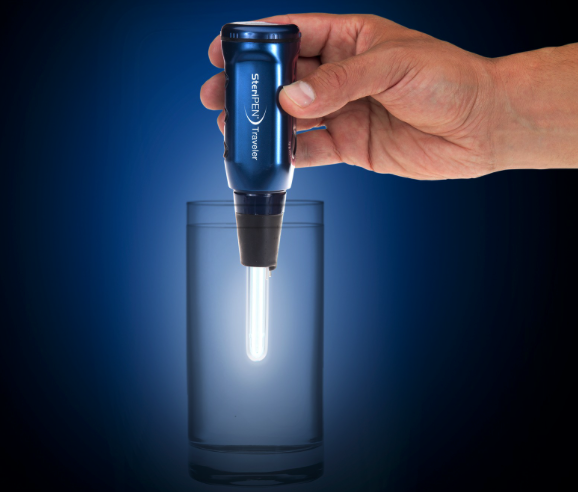
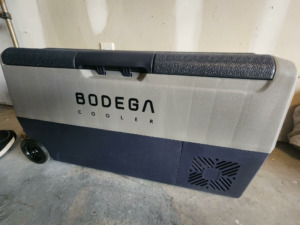

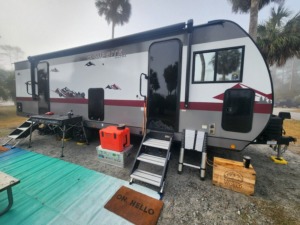
Comments
Hello Tucker,
I have been working in and around municipal water treatment plants for decades now and actually stumbled across your site when researching a problem one of my client is having.
The large scale water treatment plants (the ones that supply drinking water to thousands of people) us UV sterilisation technology but as a last line of defence after all the physical filtration technologies have done their job then the chemical cleaning technologies have done their job.
If I was stuck in out the wilderness trying to fashion up something to get drinking water I would definitely be looking at combining the technologies in a similar fashion.
cheers.
Author
Hey Remy!
Thanks for the comment! I think you hit the nail on the head as far as being “better safe than sorry” goes. Improper water filtration can ruin even the best laid plans in the backcountry, so using multiple methods of filtration is always going to be a safe bet!
I was intrigued when I saw your article because I used an ultraviolet light system as part of my home filtration system many years ago. I do a lot of hiking and I did not know that the technology was now in such a small size. I have always used drops of bleach in water. As well, unless desperate, I will only take water from a relatively deep spot of running water. Your information about how this tool functions is clear and the comparison of various models is really valuable. I am bookmarking this site for future reference. Thanks for the information.
Author
Hi Anastazja!
UV technology has come a long way for backpacking water filters. I would definitely recommend checking one out. I will also share that I saw a water quality study for the Sierra Nevada mountains a few years back that suggested surface water in lakes actually contained fewer bacteria, protozoa, and cryptosporidium than deeper water and moving water. The theory was that larger protozoa will settle out in water that is moving less frequently and the surface water is naturally being radiated by the sun. That said, this will change based on your location. So it’s worth looking into these kinds of studies in your area!
Does the Steripen come in a larger size to purify up to a gallon of water at a time? What are some of the disadvantages of the Steripen? What is the life of the Steripen? Can the element be changed out? and if so is it economical? What happens if the light goes out in the middle of purifying and you can’t get any other response from it? It sounds like an amazing product to have when hiking or light camping.
Jerry
Author
Hey Jerry!
Great questions. I’ll try to answer them to the best of my ability and I hope it’s helpful!
1. Does the Steripen come in a larger size to purify up to a gallon of water at a time?
It does not. These filters are specifically meant for filtering water in half-liter or one-liter water bottles. That being said, the Katadyn Group that makes the Steripen offers a wide variety of filtration systems, including some that are meant for larger quantities. Check them all out here.
2. What are some of the disadvantages of the Steripen?
– The need to carry replacement batteries
– The need for a clear water bottle to make sure the light stays on throughout the purification process (not required, but it helps to monitor the operation and make sure it’s doing its job)
– It sometimes feels like you’re relying on a magic wand to purify your water. In other words, you need to do your homework on the benefits of UV purification and have faith that it’s actually working. For some reason,
3. What is the life of the Steripen?
This will depend on the model you choose, but the Steripen Ultra, for example, is rated with a lamp lifespan of 8,000 treatments. For fun, let’s say you average filter three liters per day (that’s three treatments). That’s a lot unless you’re a permanent backpacker, but you’d complete 1,095 cycles in a calendar year at that rate. That means your Steripen would last a little over seven years at that usage rate.
4. Can the element be changed out? and if so is it economical?
The element, in this case, is the UV light itself. And I’ve never heard of one being replaced on these models. I’d wager it would be just as economical to purchase an entirely new unit if it were to break.
That said, the element isn’t susceptible to cracking like the elements on traditional pump-style water filtration systems or becoming clogged like on newer gravity-fed systems. So that’s an advantage for the Steripen.
5. What happens if the light goes out in the middle of purifying and you can’t get any other response from it?
I’ve been there! Odds are, you just need to change out the batteries and the issue will be resolved. So that comes back to one of the disadvantages of having to carry extra batteries for this water filtration solution.
As a rule of thumb, I never backpack for multiple days without a minimum of two different water filtration solutions. Whether it’s iodine tablets or a gravity-fed filtration system like the Sawyer, I highly recommend having a backup just in case something malfunctions with the Steripen.
Hi Tucker,
I appreciate your great articles. Can protozoa, bacteria, and viruses repair their DNA or reactivate if you wait too long after UV treating the water. I was reading a section on UV water treatment in the BACKPACKERS.COM Water Filter and Water Purification Guide where it said “One big note about UV purification: It does not kill the pathogens. Instead, it scrambles them so they cannot reproduce, thereby causing them to be harmless to your body. This is true unless the water sits for hours, in which case they can “come alive” again and wreak havoc. Don’t sterilize large batches of water you don’t plan to drink until later on.”. Do you know if this is correct, and if so, how long that would take under different temperature regimens.
It doesn’t seem right, but who knows what living organisms, especially microscopic ones, are capable of. I appreciate any information you can provide.
Author
Hi Brian!
I’ve personally never heard this, but it doesn’t sound too far-fetched to me. To steer clear, I’d just say sterilize and drink within 12-24 hours, which is usually the case when backpacking. But if you’re car camping, that’s a different story. I did find this study that might be worth diving into if you’re curious: https://www.ncbi.nlm.nih.gov/pmc/articles/PMC126789/
Judging from the table you posted on how many people get sick, it would appear that statistically, no method seems to protect against sickness since the baseline no treatment had an 8.2% sickness rate which was only bettered by the gravity filter. But even then the sample sizes are relatively small so I’m not sure the difference would be statistically significant (< 0.04 p value).
I know it’s a little old but what a great article! Thank you. I just spent 3 days on Steripen treated creek water so I’ll see what happens. One note, “One push will purify a half-liter and two pushes will set your pen to purify a full liter.” is incorrect. It’s only one push for a whole liter, two for a half.
Author
Great catch! I’ll double check the info in this article and update it ASAP. Thank you!